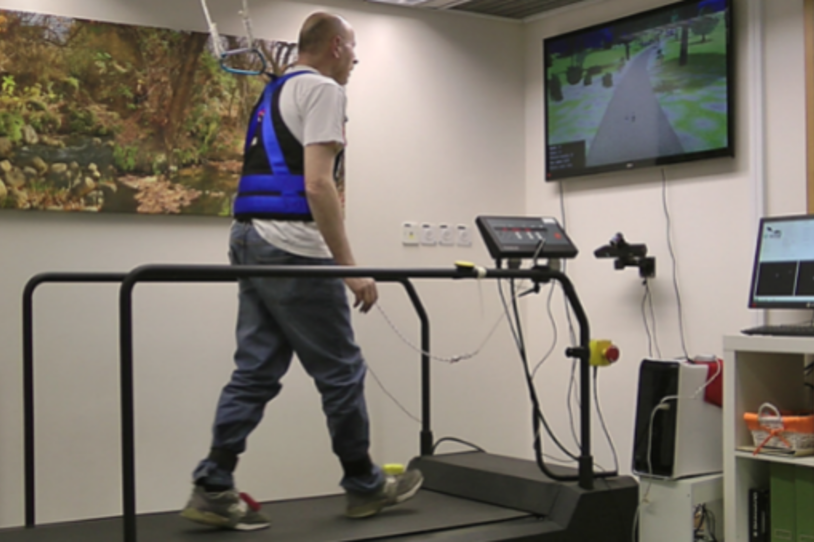
The virtual reality program used in this study projected participants' footsteps onto a screen that also showed objects and distractions to avoid while walking.
Virtual reality - a multimedia experience that lets one interact with a different environment - is surging in popularity among videogame manufacturers and news organizations. A new study shows it may be useful, too, in Parkinson's care to prevent falls.
The Michael J. Fox Foundation funded a pilot study in 2007, Virtual Reality to Reduce Fall Risk in Patients with Parkinson's Disease, by a group of researchers from the Tel Aviv Medical Center and Tel Aviv University, Israel. With positive data from that trial, the group earned a grant from the European Union to conduct a larger follow-up study.
The results from that study, published in The Lancet last week, show a significant reduction in falls among high-risk adults, including people with Parkinson's disease, who completed a treadmill and virtual reality training program. A control group that completed treadmill training only did not see as significant a reduction in falls.
The research team believed that the big improvement seen in participants with Parkinson's disease could be due to a number of factors, including that they had higher rates of falls at the start of the study or that virtual reality was able to help improve cognitive and motor skills which are affected in Parkinson's disease, reported Dan Schwartz in the Israeli Times.
"Training in the virtual reality environment might have enhanced performance during attention-demanding and challenging situations, thereby contributing to real-world fall avoidance during the six- month follow-up period," wrote the researchers in the paper.
Addressing a Common, Dangerous Problem
Falls are common among people with Parkinson's disease, dementia or mild cognitive impairment and can lead to serious injury, loss of independence and decrease in quality of life. The motor symptoms of Parkinson's include walking and balance difficulties, but there is also a cognitive component to falls. Obstacle negotiation, encountering an object and moving around or over it, requires attention, planning and judgement that may be compromised with Parkinson's disease. The study team speculated (or hypothesized) virtual reality may strengthen the thinking processes that could help avoid falls.
Across five clinical sites in Belgium, Israel, Italy, the Netherlands and the United Kingdom, 302 participants were randomized to the treadmill training only or treadmill and virtual reality. They completed a 45-minute training three times per week over six weeks. To enroll, volunteers must have had a history of falls and were categorized into three groups: those with unexplained falls, those with mild cognitive impairment and those with Parkinson's disease.
The virtual reality experience showed obstacles and distractors on a large screen in front of the treadmill and also displayed the participant's footsteps navigating the scene. This visual feedback, and auditory prompts, helped the volunteers learn motor strategies. The treadmill-only group focused on increased duration and speed of walking.
For six months after the training program, participants recorded their falls on a paper, online or smartphone app-based calendar. The study team checked in each month and had the volunteers come in for assessments one week, one month and six months after the training ended.
Avoiding More Falls with Virtual Reality
The table below shows that treadmill training with virtual reality cut the incidence rate (frequency) of falls nearly in half. The Parkinson's subgroup saw an even greater response.
Incidence Rate (Frequency) of Falls Over Six Months in Study Groups
|
Full Treadmill |
Full Treadmill and Virtual Reality Group |
Treadmill Only Parkinson's Subgroup |
Treadmill |
|
|
Six Months |
10.71 |
11.92 |
19.23 |
18.26 |
|
Six Months |
8.27 |
6.00 |
16.48 |
8.06 |
People in the treadmill and virtual reality group also showed greater improvement in decreased gait variability during obstacle negotiation (that is, they didn't have to slow down or stop as much when encountering an object) and obstacle clearance.
First author of the study, Anat Mirleman, PhD, noted that: "We were very pleased to see the added value of the cognitive training component of the intervention, as delivered via virtual reality, in comparison to the active control comparison of treadmill training alone."
In an email to MJFF staff, senior author Jeffrey M. Hausdorff, PhD, added "The results among the subgroup of people with Parkinson's disease were especially exciting. I would like to thank the MJFF for its past and ongoing support. The pilot funding was successfully leveraged and transformed to make a bigger impact."
Interested in trying virtual reality for Parkinson's care? Talk to your physician and physical therapist about options in your area.
For more information about what you can do to prevent or mitigate falling risk, read our recent newsletter featuring this article by Rachel Dolhun, MD, our Foundation's VP of Medical Communications.
Participate in studies such as these by registering with our online matching tool Fox Trial Finder. Already registered? Make sure your profile is up to date to be notified of new studies that need you or browse trials in your area.
